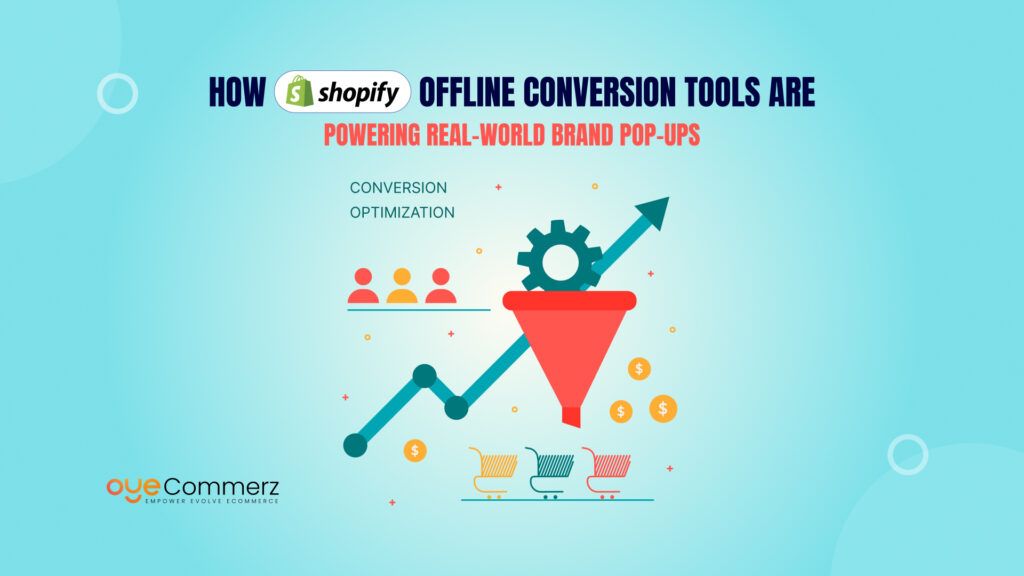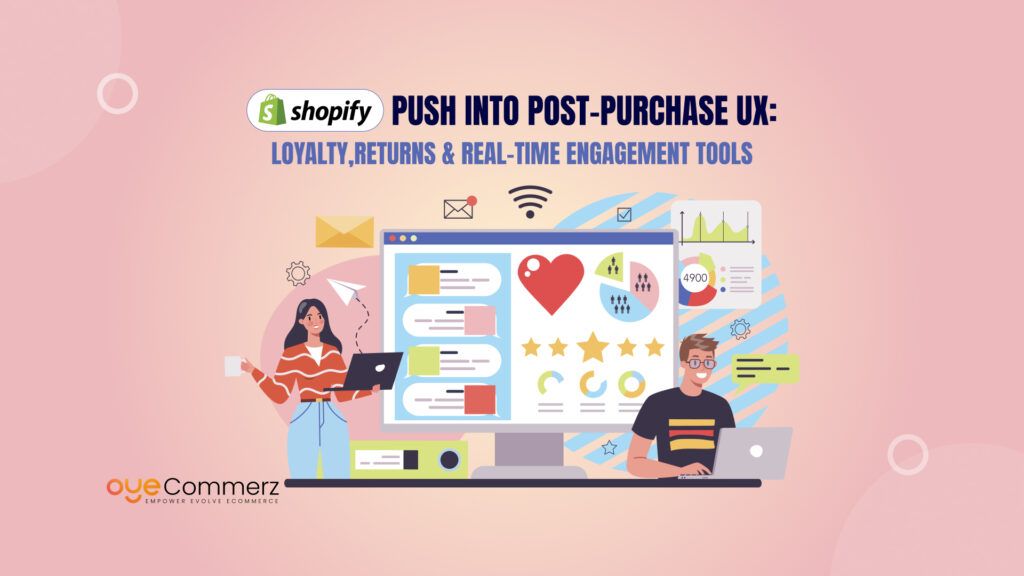Do you know? As of 2025, Shopify commands a significant 29% share of the U.S. eCommerce platform market, positioning it as the leading choice for online retailers. In contrast, Squarespace holds a 14% market share, reflecting its focus on general website building rather than specialized eCommerce functionalities.
For businesses aiming to scale their online presence, the transition from Squarespace to Shopify offers enhanced eCommerce capabilities, including advanced inventory management, a wide array of third-party app integrations, and robust SEO tools. This shift is increasingly common among merchants seeking a platform tailored to comprehensive online retail operations.
Table of Contents
ToggleWhy Businesses Outgrow Squarespace
Ideal for Beginners, But…
Squarespace is an excellent starting point for entrepreneurs who want to quickly set up a visually appealing online store. With its sleek templates and intuitive drag-and-drop interface, it’s easy for anyone to create a professional-looking website without technical expertise. Squarespace works well for small stores that offer a limited range of products and need minimal customization. However, once the business starts to grow and demands more advanced eCommerce functionality, its simplicity becomes a limitation.
Common Pain Points as Businesses Grow
As a business expands, Squarespace’s limitations become evident. Managing large product catalogs becomes cumbersome, and the lack of advanced inventory management tools can lead to operational inefficiencies. Additionally, Squarespace offers limited payment gateway options, making it difficult for businesses to expand globally or provide diverse payment methods. On the marketing side, Squarespace lacks essential features like A/B testing, marketing automation, and abandoned cart recovery, features that are critical for scaling an online store.
Missed Growth Opportunities
Squarespace’s basic eCommerce features can hinder growth in the long run. Businesses that need to scale often experience inconsistent user experiences due to limited customization options and fewer advanced integrations. Without the ability to create personalized shopping journeys, brands miss out on opportunities to increase conversions and build customer loyalty. For growing businesses, staying with Squarespace may lead to stagnation and missed potential for revenue growth.
Shopify: A Platform Designed to Scale
Scalable Infrastructure for Growing Stores
Why It Matters: As an online store grows, increased traffic and larger product catalogs can strain a platform’s resources. Without a scalable infrastructure, slow page loads and site crashes can lead to lost sales and frustrated customers.
Shopify Advantage:
Shopify’s cloud-based architecture offers unlimited bandwidth and storage, ensuring that your website runs smoothly even during high-traffic periods, such as Black Friday or holiday sales. Its automatic scaling capabilities allow your store to handle sudden surges in traffic without compromising speed or performance. This means you can focus on growing your business without worrying about backend limitations.
Customization Without Limits
Why It Matters: A brand’s identity is essential for standing out in a crowded market. To build a unique online presence, businesses need the ability to customize their store beyond pre-designed templates.
Shopify’s Flexibility:
Shopify provides complete design control through its Liquid templating language, allowing businesses to create fully customized themes that reflect their brand. Beyond design, Shopify’s API integrations make it easy to add new functionalities or connect with external platforms, giving you the flexibility to tailor your store’s features to match your specific business needs. Whether you need custom checkout experiences or advanced product filters, Shopify empowers you to go beyond the basics.
Built-in Analytics for Smarter Decisions
Why It Matters: Data-driven decisions help businesses optimize their marketing strategies, improve user experiences, and increase sales. Without actionable insights, it’s difficult to understand customer behavior and refine your store’s performance.
Shopify Analytics:
Shopify offers advanced reporting and analytics tools that provide deep insights into sales trends, customer preferences, and product performance. It integrates seamlessly with Google Analytics and Facebook Pixel, allowing businesses to track customer journeys across multiple touchpoints. These insights empower store owners to make data-backed decisions that lead to better conversion rates and sustained growth. By leveraging Shopify’s analytics, businesses can optimize their marketing efforts, fine-tune product offerings, and identify opportunities for upselling and cross-selling.
Shopify’s combination of scalability, customization, and data analytics makes it an ideal platform for businesses that want to move beyond the limitations of Squarespace and achieve sustainable growth. For those exploring Squarespace alternative, Shopify offers a more robust solution with advanced features that support long-term success.
Migration from Squarespace to Shopify: Step-by-Step Guide
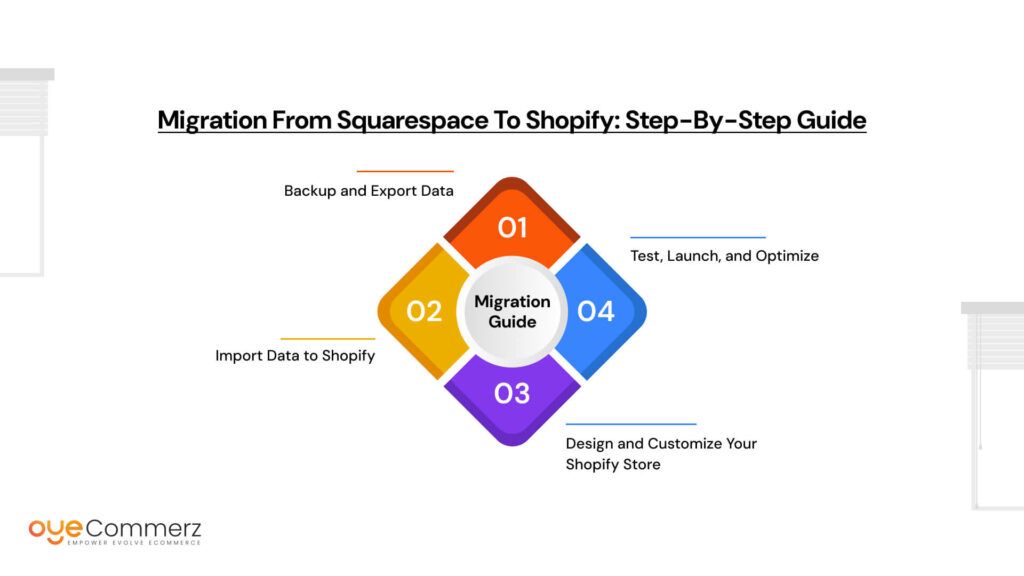
Switching from Squarespace to Shopify is a strategic move that can unlock new growth opportunities for your business, making it one of the best Squarespace alternative for scaling and customization.
While Squarespace is known for its sleek designs, Shopify provides a stronger eCommerce infrastructure designed to support scaling businesses. Shopify’s platform offers advanced SEO tools, better inventory management, and multiple sales channels, including social media and marketplaces. These features ensure that your store not only attracts more traffic but also converts visitors into loyal customers.
Another significant advantage is Shopify’s flexible checkout and payment system. Shopify supports over 100 payment gateways, allowing businesses to accept payments from a global audience. Its optimized checkout process reduces cart abandonment and ensures a smooth purchasing experience. For businesses that want to expand internationally or streamline operations, Shopify’s infrastructure offers the flexibility and security needed to scale efficiently.
Step 1: Backup and Export Data
Before starting the migration process, it’s crucial to back up all your existing data on Squarespace. This includes product catalogs, customer information, order history, and blog content. Exporting this data ensures that no critical information is lost during the transition.
Pay special attention to your current SEO settings. Squarespace automatically generates URLs and meta descriptions, which might not be preserved during migration. Export a list of URLs and analyze your current site’s SEO performance to prevent ranking drops. Consider setting up 301 redirects after the migration to maintain SEO equity and avoid broken links.
Step 2: Import Data to Shopify
Once your data is backed up, the next step is to import it into Shopify. Shopify offers several import tools and apps, such as Cart2Cart or Matrixify, which automate the process and reduce manual effort. If you prefer a manual approach, Shopify’s admin panel allows you to upload CSV files for products, customers, and orders.
After importing the data, double-check everything. Verify that product listings are correctly categorized, customer information is intact, and metadata has been preserved. Small discrepancies can impact customer experience and SEO performance, so take the time to ensure all data is accurately migrated.
Step 3: Design and Customize Your Shopify Store
With your data imported, it’s time to design and customize your Shopify store. Shopify offers over 70 professionally designed themes that are optimized for eCommerce and conversions. Choose a theme that aligns with your brand and provides the functionality you need.
To further enhance your store’s capabilities, explore Shopify’s App Store. You can add apps to automate marketing, improve customer engagement, and streamline order management. Popular apps for email marketing, abandoned cart recovery, and loyalty programs can help you drive sales and increase customer retention. Customizing your store’s layout, navigation, and product pages ensures that your new Shopify site delivers a seamless and engaging shopping experience.
Step 4: Test, Launch, and Optimize
Before making your Shopify store live, conduct thorough testing to ensure everything works perfectly. Perform multiple test transactions to verify that payment gateways, shipping settings, and discount codes are functioning correctly. Check for broken links, confirm product descriptions, and ensure that customer data has been transferred accurately.
After launching your store, focus on optimization. Implement advanced SEO techniques to maintain or improve your search engine rankings. Optimize page speed, update meta descriptions, and ensure mobile responsiveness to enhance user experience. Monitor your site’s performance using Shopify’s built-in analytics and make data-driven adjustments to maximize conversions.
Shopify vs. Squarespace: Key Feature Comparison
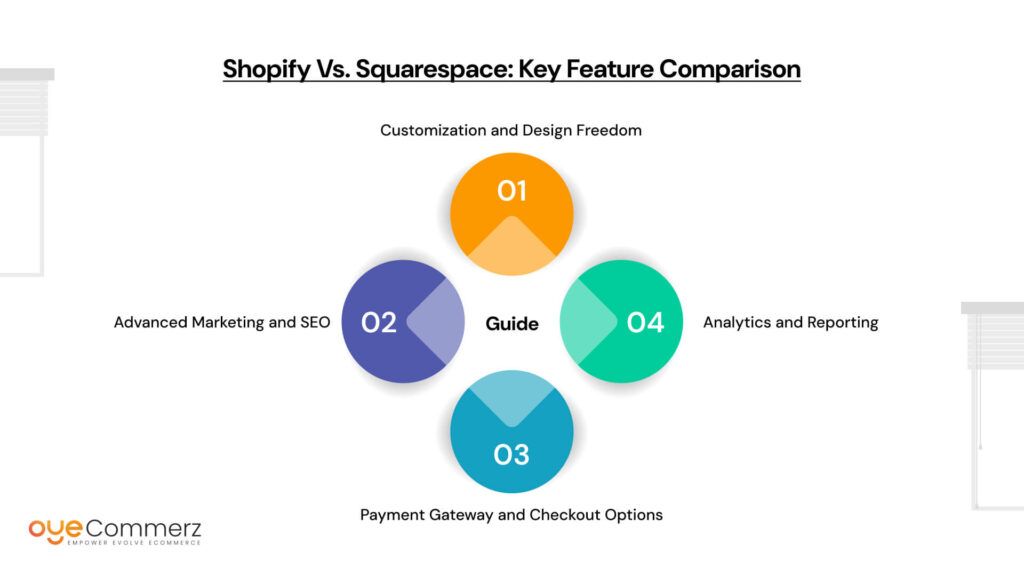
When choosing an eCommerce platform, understanding the key differences between Shopify and Squarespace can help you make a more informed decision. While Squarespace excels in design simplicity, Shopify offers a more comprehensive suite of tools to support growing businesses. Below is a detailed comparison of the essential features that set these platforms apart.
A. Customization and Design Freedom
Shopify:
Shopify offers unparalleled design flexibility, allowing store owners to fully customize their websites. With over 70 professionally designed themes optimized for conversions, Shopify ensures that your store looks great while driving sales. For those who need advanced customization, Shopify uses Liquid, its proprietary templating language, giving developers complete control over design and functionality. This makes it easier to create a unique and tailored shopping experience that aligns with your brand.
Squarespace:
Squarespace is known for its beautifully crafted templates, but its customization options are more limited. While it allows some flexibility in design, the ability to modify and personalize layouts is constrained compared to Shopify. Squarespace does not offer the same depth of control over backend code, which makes it harder to create a fully customized eCommerce store. This limitation can restrict businesses from achieving a truly distinctive brand identity as they scale.
B. Advanced Marketing and SEO
Shopify:
Shopify provides built-in SEO tools that allow store owners to optimize their websites for search engines easily. It offers control over meta tags, URL structures, and automatic sitemap generation, ensuring that your products and content are easily discoverable. Beyond SEO, Shopify excels in marketing automation with features like abandoned cart recovery, retargeting ads, and personalized email marketing. These tools help increase conversions and bring back lost customers, making Shopify a powerful choice for growth-oriented businesses.
Squarespace:
Squarespace offers basic SEO controls, such as editing page titles and descriptions, but it lacks the advanced SEO capabilities that Shopify provides. Additionally, Squarespace’s marketing automation options are minimal, limiting your ability to re-engage customers or run complex marketing campaigns. Without robust retargeting tools and abandoned cart recovery, Squarespace users may miss out on potential sales and repeat business.
C. Payment Gateway and Checkout Options
Shopify:
One of Shopify’s biggest advantages is its extensive payment gateway support. It integrates with over 100 payment gateways, allowing businesses to accept payments from customers worldwide. Shopify Payments, its native gateway, offers a seamless one-click checkout experience, reducing friction at the final stage of the buying process. Shopify also supports multi-currency payments, making it easier for international businesses to expand their reach.
Squarespace:
Squarespace offers limited payment gateway options, primarily supporting Stripe and PayPal, which restricts flexibility for businesses seeking diverse payment methods. It also lacks advanced checkout customization options, making it a less attractive choice for businesses considering Squarespace alternative. Without the ability to customize and streamline the checkout process, Squarespace users may experience a less optimized buying experience and higher cart abandonment rates.
D. Analytics and Reporting
Shopify:
Shopify provides comprehensive analytics and reporting tools that offer deep insights into customer behavior, order performance, and sales trends. Store owners can access detailed reports, including product analytics, customer retention rates, and marketing performance. Shopify’s integration with Google Analytics and Facebook Pixel allows for seamless tracking across multiple channels, enabling data-driven decision-making to optimize growth strategies.
Squarespace:
Squarespace offers basic analytics that provides an overview of site traffic, page views, and basic sales data. While this information is useful for small businesses, it lacks the in-depth insights necessary for scaling operations effectively. Without advanced reporting capabilities, Squarespace users may struggle to make data-informed decisions that can drive long-term growth
Feature Comparison Table
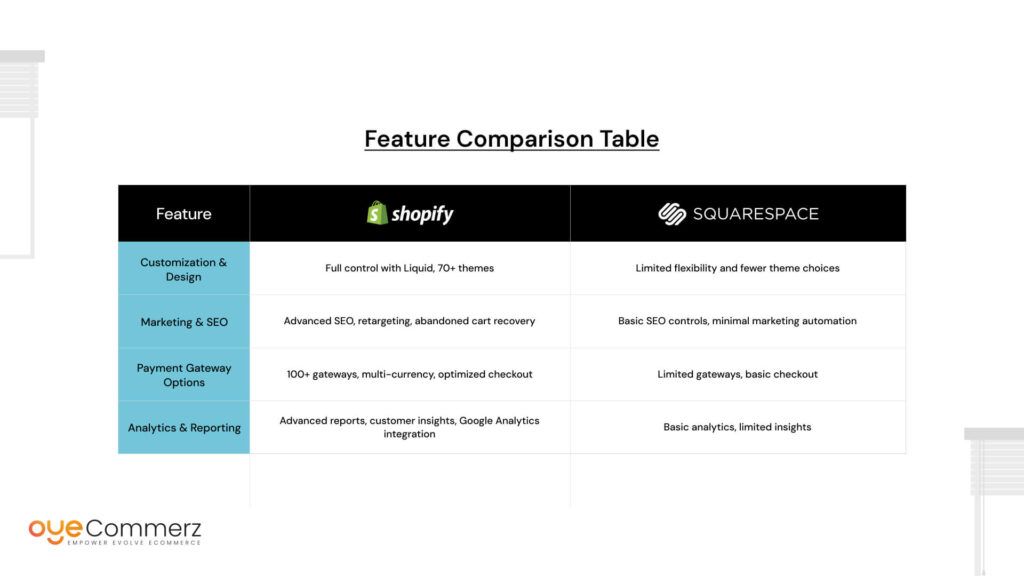
For businesses looking to scale and expand their eCommerce capabilities, Shopify offers a more robust platform with advanced customization, marketing tools, and payment flexibility. While Squarespace may be suitable for smaller stores or portfolio websites, its limitations become evident as businesses grow. If your goal is to create a high-performing, data-driven online store with global potential, Shopify emerges as the clear winner in this feature comparison.
App Ecosystem and Integrations: A Closer Look
A. Shopify App Store: Endless Possibilities
Shopify’s App Store offers over 8,000 apps designed to enhance every aspect of an eCommerce business. From automating marketing campaigns and streamlining customer service to optimizing inventory management, Shopify’s diverse range of apps caters to businesses of all sizes. Popular integrations such as Google Ads, Facebook Shop, and Instagram allow businesses to expand their reach and drive more traffic to their stores. Whether you need tools for email marketing, loyalty programs, or upselling, Shopify’s app ecosystem ensures that you have everything you need to boost sales and improve efficiency.
B. Squarespace’s App Limitations
In contrast, Squarespace offers a limited selection of add-ons and integrations, which can restrict a growing business’s ability to scale. While Squarespace does provide essential tools for website management and blogging, it lacks advanced eCommerce integrations that Shopify offers. The absence of a robust app ecosystem makes it challenging for businesses to add new features or automate repetitive tasks, limiting their growth potential.
C. Why a Robust App Ecosystem Matters
A dynamic app ecosystem is essential for adapting to evolving business needs. Shopify’s wide array of integrations allows businesses to add features as they grow, automate time-consuming tasks, and stay ahead of market trends. This flexibility ensures that your store can scale effortlessly and stay competitive in a rapidly changing eCommerce landscape.
Shopify vs. Squarespace: Pricing Breakdown and ROI
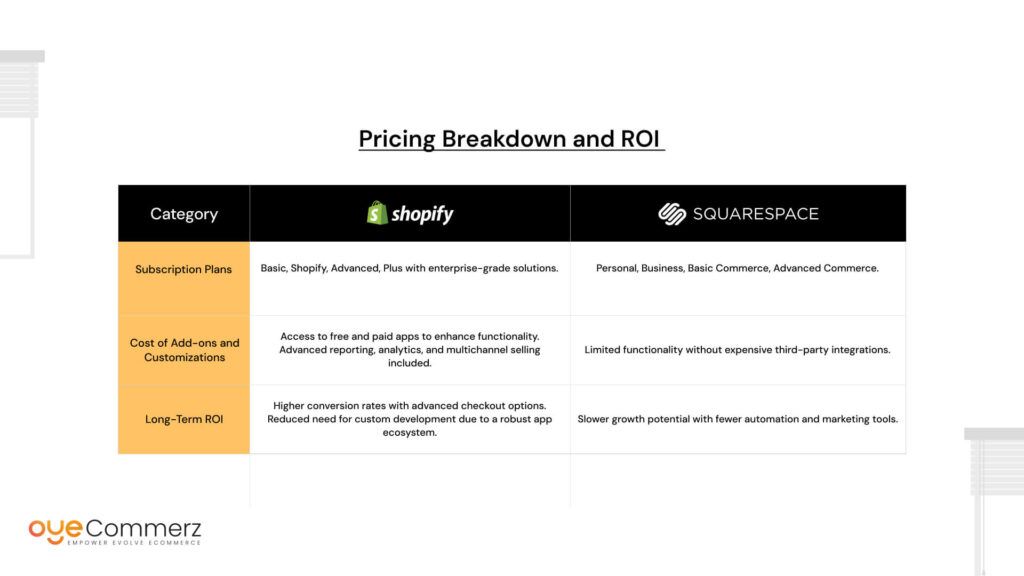
Design, UX, and Customer Journey: Who Does It Better?
A. Squarespace’s Strength
Squarespace excels in providing visually stunning templates that are ideal for portfolio websites, blogs, and creative projects. Its drag-and-drop interface makes it easy for non-technical users to create attractive websites without much effort. However, these templates, while beautiful, are often not optimized for high-conversion eCommerce stores. For businesses that prioritize aesthetics over functionality, Squarespace offers a solid starting point.
B. Shopify’s Strength
Shopify, on the other hand, is built with eCommerce at its core. Its themes are not only visually appealing but also optimized to drive conversions. Shopify templates are designed to ensure faster page load speeds, intuitive navigation, and a seamless checkout process. Additionally, Shopify’s ability to personalize product recommendations and integrate upselling techniques ensures that customers enjoy a highly engaging and tailored shopping experience.
C. Why UX Impacts Sales
User experience (UX) plays a critical role in determining conversion rates and customer retention. A well-optimized shopping journey reduces friction, leading to fewer abandoned carts and higher repeat purchases. Shopify’s focus on fast-loading pages, smooth checkout, and advanced personalization contributes directly to better sales outcomes. For eCommerce businesses focused on growth, investing in a platform that prioritizes UX is key to long-term success.
Customer Support and Community: Who’s Got Your Back?
A. Shopify’s 24/7 Support System
Shopify offers round-the-clock support through live chat, phone, and email, ensuring that help is always available when needed. Their response times are quick, and the support team is well-equipped to handle both technical and non-technical queries. Additionally, Shopify provides a vast knowledge base, video tutorials, and an active community forum where users can find solutions to common issues. This robust support ecosystem gives store owners the confidence to manage and grow their businesses effectively.
B. Squarespace’s Limited Support Options
Squarespace’s support system, while helpful, is more limited compared to Shopify. It offers email and chat support, but response times can be slower, especially during peak hours. The platform’s knowledge base is smaller, and the user community is less active, making it harder for store owners to find quick solutions to technical challenges. This can be a disadvantage for growing businesses that require immediate assistance to maintain seamless operations.
C. Why Reliable Support Matters
In the fast-paced world of eCommerce, timely support can make the difference between resolving an issue quickly or losing potential sales. Shopify’s responsive support and extensive knowledge resources ensure that technical glitches, payment issues, or order management challenges are addressed promptly. This level of support provides peace of mind to business owners, allowing them to focus on scaling their stores without interruptions.
Is Squarespace Alternative the Right Fit for Your Business?
When to Choose Shopify
Shopify is the right choice if you’re serious about scaling your online store and need a platform that supports advanced eCommerce features. It’s ideal for businesses that require marketing automation, multiple payment gateways, and seamless third-party app integrations. Shopify’s flexibility makes it suitable for growing brands looking to optimize their operations and improve customer experiences.
When Squarespace Might Be Enough
Squarespace is better suited for portfolio websites, blogs, or small online stores that require minimal eCommerce functionality. If your primary goal is to showcase content or sell a limited range of products without complex backend requirements, Squarespace’s simple interface and beautiful templates may be sufficient. However, for businesses aiming to scale and maximize ROI, Squarespace alternative like Shopify remain the more powerful and scalable option.
Ready to Make the Switch from Squarespace to Shopify?
At OyeCommerz, we specialize in seamless Squarespace to Shopify migration tailored to your business needs. From product transfers to custom theme development, we handle every detail so you can focus on growing your brand. Let us help you unlock Shopify’s full eCommerce potential, migrate with confidence!
Contact to Migrate your Site to Shopify Now
Conclusion
In the evolving landscape of online retail, Shopify emerges as a superior alternative to Squarespace for businesses prioritizing eCommerce excellence. Its extensive suite of features, scalability, and dedicated support for online selling make it a preferred platform for merchants aiming to expand their digital footprint.
For those considering a Squarespace to Shopify migration, the transition promises access to a more robust infrastructure designed to meet the demands of modern eCommerce. Embracing Shopify can be a strategic move to enhance operational efficiency and drive business growth in the competitive online marketplace.
Frequently Asked Questions
Shopify offers more powerful eCommerce tools, better scalability, advanced app integrations, and superior inventory management, making it ideal for serious online stores.
It’s user-friendly, highly customizable, supports multi-channel selling, and provides top-tier security and performance, making it the go-to platform for online businesses.
WooCommerce is a strong alternative, especially for those comfortable with WordPress, offering flexibility and control over store customization.
Shopify’s main advantage is its all-in-one solution for eCommerce, offering ease of use, scalability, 24/7 support, and a vast app ecosystem.
Yes, AI personalizes gamified experiences by tailoring rewards and challenges based on user behavior.



